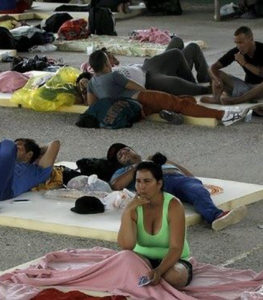Refugees from Costa Rica on the way – here’s why
An announcement by Prime Minister Malcolm Turnbull at the recent United Nations Summit for Refugees and Migrants that Australia would accept refugees from Costa Rica took many by surprise.
Australia has not seen large numbers of refugees from Central America since the 1980s, and the number of Latin American Australians is a relatively low proportion of the overall population.
So what was behind the move?
The Prime Minister’s speech at the Summit in New York revealed several new developments; that Australia would increase its funding for humanitarian capacity-building in the countries neighbouring Syria; that it would increase the number of refugees settled from other countries from 13,750 to 18,750 in 2018-19; and, that it would assist in resettling refugees currently based in Costa Rica.
 There was no word on exactly how many refugees would be accepted from Central America, nor on the timeline for their arrival or the nature of any international deals that underpin their arrival.
There was no word on exactly how many refugees would be accepted from Central America, nor on the timeline for their arrival or the nature of any international deals that underpin their arrival.
According to the Australian Institute of International Affairs (AIIA), refugees living in the Costa Rican refugee centres have fled violence in El Salvador, Guatemala and Honduras – a region that has become infamously known as the ‘Northern Triangle’.
Dr Robert Mason, writing in the AIIS’s journal, said that the number of people seeking to escape the area is rapidly increasing.
“There has been a 500 per cent increase in the three years leading to 2015, when 109,800 people sought to flee. While most people sought to reach Mexico and the US, Costa Rica is a closer and more affordable destination for many,” said Dr Mason, a lecturer in Migration and Security Studies at Griffith University.
“Asylum applications in Costa Rica quadrupled in the three years to 2015. With a population of 4.8 million, the country is an important destination for those seeking safety and has an established reputation for assisting those in need. Costa Rica already hosts a substantial number of Salvadorans who arrived in the country during the 1980s, and who provide a level of social support for new arrivals,” he said.
Dr Mason says the USA has supported Costa Rica over many years for a number of reasons.
In August 2016, nine Central and North American countries announced the San José Declaration to strengthen protections for refugees in Central America and one of the aims was to dissuade displaced people from attempting the dangerous journey north.
“To achieve this, the US collaborated with the UNHCR to pre-screen refugees in their home country when possible. Those deemed eligible, and at immediate risk of violence, could then be moved to a Costa Rican centre,” Dr Mason said.
He said the program ran in parallel with the recently-expanded Central American Minors Refugee Program, which seeks to enable children from El Salvador, Guatemala and Honduras to escape endemic violence.
The region is plagued by rampant gang violence that can be traced to El Salvador’s decade-long civil war.
“Young men were displaced by the conflict and sought work in the US. Once in the cities of California, they formed part of an already existing gang culture that provided an identity and means of support,” Dr Mason said.
“Thousands of gang members were deported back to El Salvador in the 1990s, after American authorities became concerned at their activities. Those who were deported had few means to support themselves and the gangs quickly reasserted themselves in El Salvador, growing rapidly to approximately 60,000 gang members. The violence steadily spread to neighbouring Guatemala and Honduras,” he said.
The recent increase in displaced people from the Northern Triangle has been prompted by a surge in gang-based violence.
“The breakdown of a truce between rival gangs and the government has caused an immediate spike in violence in El Salvador, with flow on effects elsewhere in the region. Gangs fight to control the lucrative cocaine trade north, but have also begun to extort money from households,” Dr Mason said.
“Youth and teenagers are forcibly recruited into the gangs. Governments’ responses have been punitive, which has further escalated the violence. The result has been an official figure of 17,422 murders in El Salvador during 2015,” he said.
Costa Rica hosts approximately 12,500 refugees and almost 10 per cent of the country’s population is now migrant or refugee.
While the US is seeking to expedite the processing of the pre-screened refugees, there are many other displaced groups in distress.
Thousands of displaced Central Americans, as well as large numbers of Colombian refugees, live with family and friends in the country’s urban centres.
There are also large numbers of migrants trapped in the country. Costa Rica has traditionally been part of the route for Cubans and Haitians and, more recently, Africans seeking to reach the US.
Those refugees waiting in the camps are desperate for a long-term solution to their displacement. Given the unlikelihood of a resolution to the conflict in the near future, this must lie in their integration into Costa Rican society or resettlement elsewhere.
Dr Mason said that while NGOs welcomed Australia’s announcement, significant questions remain unresolved.
“Is Australia the most appropriate country to settle these refugees, given many of them have family in the US?
“While Australia’s Central American population has remained committed to achieving social justice in their former homes, their numbers are relatively low.
“What is the capacity of the humanitarian settlement services to assist in the settlement of this unique cohort? In answering these key questions, Australia will be able to reassure those at risk in Costa Rica and prepare to ensure their future well-being in their adopted country,” Dr Mason said.
Laurie Nowell
AMES Australia Senior Journalist












